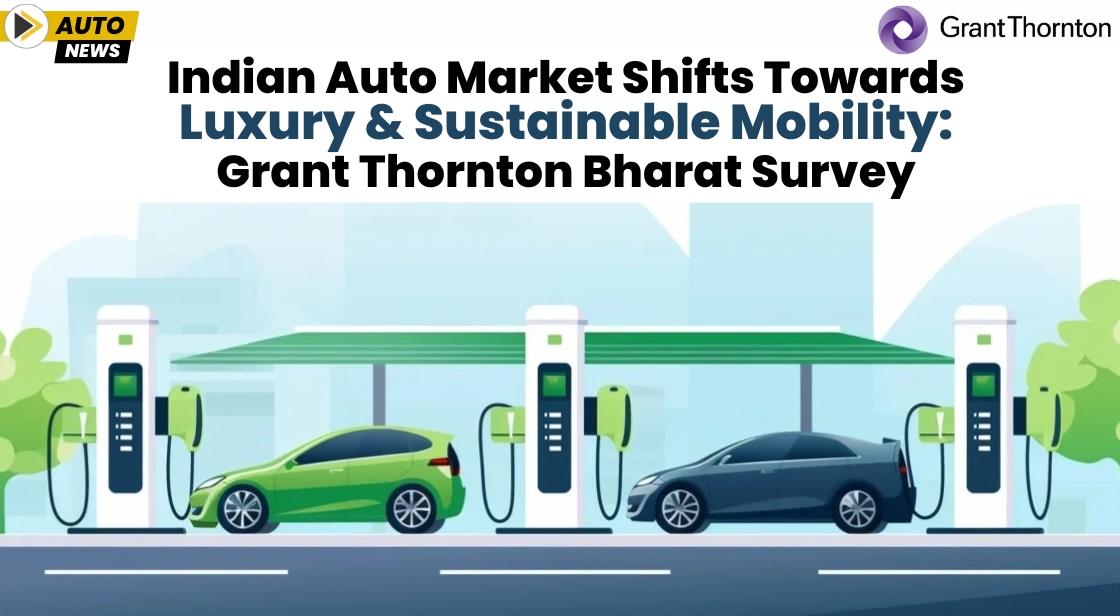Indian Auto Market Shifts Towards Luxury and Sustainable Mobility: Grant Thornton Bharat Survey

News Synopsis
Consumers in India are increasingly leaning toward both luxury and sustainable mobility options, ushering in a transformative phase for the country’s automotive industry. According to a survey conducted by Grant Thornton Bharat, the Indian passenger vehicle (PV) market is undergoing significant shifts in consumer preferences.
As per the survey titled 'Shifting Gears: Understanding Passenger Vehicle Market Trends', a notable 85 percent of participants indicated a preference for premium models, while hybrid vehicles are gaining traction as a preferred sustainable option over fully electric vehicles (EVs).
The survey, which gathered responses from over 3,500 participants nationwide, reflects a developing consumer inclination toward environmentally responsible yet luxurious automotive choices. Specifically, 40 percent of respondents are now favoring hybrid vehicles, whereas only 17 percent have shown interest in EVs.
This trend underlines the current transitional nature of the market, with 34 percent still opting for petrol-powered vehicles, underscoring consumer caution amid ongoing shifts in automotive technology.
Hybrids as a Transitional Solution
The survey suggests that hybrids may play an essential role in the Indian market, acting as a bridge for consumers who are not yet ready to fully embrace EVs due to the country's underdeveloped EV infrastructure and lack of widespread incentives.
As hybrid vehicles gain popularity, they are seen as a gateway for future EV adoption, familiarizing consumers with sustainable technology while allowing them to wait for improved EV-related infrastructure and government incentives.
Meeting Evolving Market Demands
The findings emphasize that Indian automakers should cater to both hybrid and EV demands to stay aligned with evolving consumer expectations. According to Saket Mehra, Partner and Auto & EV Industry Leader at Grant Thornton Bharat, "As market dynamics evolve, automakers must adapt to shifting consumer preferences."
Mehra further highlighted that the upcoming festive season—which typically contributes 30 to 40 percent of annual sales—is particularly critical for the automotive sector in India. However, growth this year may be tempered by high inventory levels, unpredictable weather, and upcoming regional elections, impacting consumer purchasing behavior.
SUVs and UVs Continue to Lead
The Grant Thornton Bharat survey findings reveal a sustained consumer preference for utility vehicles (UVs) and sports utility vehicles (SUVs). These segments have recorded a 13 percent year-on-year growth, now accounting for 65 percent of total passenger vehicle sales. Despite a somewhat sluggish first half of FY25, with a modest 0.5 percent rise in overall domestic sales, the resilient demand for SUVs and UVs highlights the strong consumer shift toward versatile vehicle models.
The industry, however, faces challenges with high inventory levels, as 7.9 lakh units worth Rs 79,000 crore were stockpiled as of September 2024. Mehra noted that the festive season presents an opportunity for automakers to address these inventory challenges, with 90 percent of respondents expecting substantial discounts during this period.
Subscription Models and Safety Features on the Rise
The survey also underscores a growing interest in subscription models and advanced safety features. Subscription options, which provide flexibility to consumers without the long-term commitment of a full vehicle purchase, are rapidly gaining popularity. Additionally, there is an increasing demand for enhanced safety in passenger vehicles, with advanced safety features now ranking above traditional factors like vehicle design and performance. This shift reflects a more safety-conscious consumer base in India, which is progressively prioritizing accident prevention and passenger protection.
Conclusion
The findings from Grant Thornton Bharat’s survey highlight a pivotal shift in the Indian automotive market, where consumer preferences are increasingly split between luxury and sustainable options, particularly hybrid vehicles. This shift signifies a strategic opportunity for automakers to align their offerings with consumer expectations for both premium and environmentally conscious choices.
Hybrids are positioned to play a critical role as a transitional technology, fostering familiarity with alternative mobility while the industry and infrastructure evolve to support wider EV adoption.
Moreover, the rising demand for SUV and UV segments, the growing popularity of subscription models, and an increased focus on advanced safety features underline the market’s dynamism and consumer-centric priorities. As automakers navigate this evolving landscape, they must adapt swiftly to meet these varied demands, especially during the critical festive season.
By embracing these changes, India’s auto industry can better cater to shifting consumer values and contribute to a sustainable, technology-driven future in mobility.









